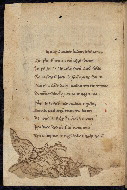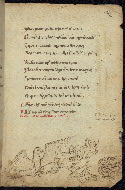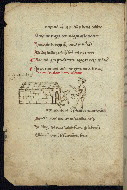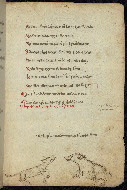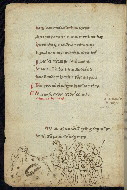Home > Digitized Walters Manuscripts
This document is a tranformation of a TEI P5 XML manuscript description incorporating images. If you have trouble reading special or non-Latin characters on this page, please make sure you have appropriate Unicode fonts installed and an up-to-date web browser.
Walters Ms. W.355, Aesop, Fables; Fables of Aesop Translated by Laurentius Valla; Distichs of Cato; Book of Proverbs; Book of Ecclesiastes
Browse images (Browse images in a new window) | TEI in XML format
W.355
Aesop, Fables; Fables of Aesop Translated by Laurentius Valla; Distichs of Cato; Book of Proverbs; Book of Ecclesiastes
Authority name: Aesop
As-written name: Aesopus
Authority name: Cato, the Elder, 234 B.C.-149 B.C.
Supplied name: Dionysius Cato
Note: Text not by Cato, but commonly believed to be by him or Cato the Younger at time; Dionysius Cato is alternative used when error recognized
Supplied name: Eusebius Hieronymus
Known as: St. Jerome
Written in Italy in the fifteenth century, this manuscript contains a collection of Latin moralizing texts. The first section is only partially preserved but contains some of Aesop's fables in Latin. Aesop (ca. 620 – 564) was a Greek fabulist about whom we know very little, other than excerpts about his life found in later sources such as Aristotle, Herodotus, and Plutarch. Although numerous fables are attributed to Aesop, it is more likely that his reputation as a storyteller led to many later fables being attributed to him retroactively (Lefkowitz 3). The second text in the manuscript is also comprised of Aesop's fables but, as the rubric indicates, this is a specific translation completed by Italian humanist Lorenzo (Laurentius) Valla (1407-1457) in 1438. From the dedication in another manuscript (Palermo, Biblioteca Comunale 2Qqc79) we know that Valla completed the translation for Ferrante, the son of the Alfonso of Arragon (also called Alfonso II, King of Naples from 1494-1495). The third text contains some of the so-called "Distichs of Cato," a collection of proverbial wisdom written in Latin. In the medieval and renaissance periods it was erroneously attributed to the Roman statesman Cato the Elder (234–149 BCE) and sometimes even his great-grandson Cato the Younger (95-46 BCE). The text, however, was most likely composed in the third or fourth century CE by an anonymous author sometimes referred to as Dionysius Cato. The final two texts in the manuscript are canonical wisdom books from the Old Testament--the Book of Proverbs and the Book of Ecclesiastes. The Book of Proverbs is prefaced by a letter (or prologue) from St. Jerome to Bishops (later Saints) Chromatius and Heliodorus, all of whom lived in the late fourth century CE. In the letter Jerome dedicates his translation of the Book of Solomon (otherwise known as Proverbs) from Greek into Latin to the two Italian clergymen, with whom he retained an ongoing correspondence.
15th century CE
Italy
Book
Literary -- Poetry
Devotional
Scriptural
The primary language in this manuscript is Latin.
- Transliteration: Explicit liber Asopi deo gras amen / amen
- Transliteration: Deo Gratias Amen
- Transliteration: Deo Gratias
Paper
Chris Clarkson has suggested the paper is fourteenth century, but given the date of the text, it is more likely fifteenth century; binding retains the original parchment guards hooked around each quire; the pastedowns and flyleaves at the front and back composed of bifolios of modern wove twentieth-century paper that are hooked in to the first and last gatherings
Foliation: i + 98 + i
Modern (?) ink foliation, upper right corners, rectos
Formula: Quire 1: 10 + 1 (fols. 1-11); Quire 2: 12 (fols. 12-23); Quire 3: 16 (fols. 24-39); Quires 4-8: 8 (fols. 40-79); Quire 9: 6 + 1 (fols. 80-86); Quire 10: 12 (fols. 87-98)
Catchwords: Occasional catchword; in black ink, visible in lower center margin versos, as on fol. 11v
Comments: Fol. 11 is tipped in at the parchment guard; fol. 80 is tipped in at the parchment guard and has its edges cut differently than the rest of the quire, further suggesting it is added in
21.5 cm wide by 13.7 cm high
9.5 cm wide by 13.0 cm high
- Columns: 1-2
- Ruled lines: 14-35
- Each individual text is ruled differently so the written surface height and width are averages
- Title: Collection of Latin moralizing texts
- Author: Aesop
- Hand note: Each individual text in a differently-sized humanist script
- Decoration note: Seven marginal line drawings illustrating Aesop's fables (fols. 1r-4r); added detail throughout in red and blue ink; in some parts the red and blue ink is used to divide text sections or lines (such as on fol. 57r); text in black ink
- Title: Aesop's Fables
- Author: Aesop
- Incipit: Tangit quod fugias quodque sequaris iter
- Contents: Variety of Aesop's fables in Latin
- Text note: Begins imperfectly with version of "De Attica terra et rege" or "Jupiter and the Frogs" (missing first line)
- Decoration note: First seven folios decorated with marginal drawings of six different fables: Frogs who asked for a king (fols. 1r-v), Hawk and the doves (fol. 2r), Thief and the dog (fol. 2v), Boar and the fox (fol. 3r), Mountain in labor (fol. 3v), wolves and the sheep (fol. 4r)
- Title: Aesop's Fables Translated by Laurentius Valla
- Author: Aesop
- Rubric: Rubric partially reads: Fabulle Esope e greco a Laurentes Vallesi secretaris illust'ssmus [?] regis aragonis dicate...dm regis secretaio [sic]
- Incipit: De vulpe et capro
- Title: Distichs of Cato
- Author: Cato, the Elder, 234 B.C.-149 B.C.
- Incipit: Cum ego Cato anima adverterem
- Contents: First ten lines are Cato addressing his sons, telling them he will teach them how to live with dignity and honor; following lines are one-line proverbial sayings or "monostichs" (monosticha) written one after another; beginning on fol. 40v are two-line phrases or "distichs" (disticha) that take up rest of text, beginning with "Si deus est animus, nobis ut carmina dicunt, Hic tibi praecipue sit pura mente colendus." Interlinear commentary added between each line of distichs
- Hand note: Commentary on each distich written in smaller script than rest of text
- Title: Book of Proverbs
- Author: Eusebius Hieronymus
- Incipit: Chromatio et helyodoro episcopis Jeronimus
- Contents: First page of text (fol. 57r) contains letter (prologue) from St. Jerome to Bishops (later Saints) Chromatius and Heliodorus; Proverbs begin on fol. 57 with "parabolae Salomonis filii David regis..."
- Title: Book of Ecclesiastes
- Incipit: Verba Ecclesiastes filii David regis ierusalem
fol. 1r:
fol. 1v:
fol. 2r:
fol. 2v:
fol. 3r:
fol. 3v:
fol. 4r:
The binding is not original.
Bound in Italy, in seventeenth (?) century, with limp (goat?) vellum; Chris Clarkson suggests that perhaps the modern repairer put the cover back on upside down based on the direction of the title on the spine; the pastedowns and flyleaves at the front and back composed of bifolios of modern wove twentieth-century paper that are hooked in to the first and last gatherings; evidence of three alum-tawed straps on the top board, suggesting a late sixteenth to early seventeenth binding to Clarkson; both the top and bottom cover made of thin paste board; title of the book written in ink on the spine reads “Esopi Fabulae Pron Eccles”
Created in Italy, fifteenth century
Leo S. Olschki (bookseller, Florence) ca. 1912 (list no. 14, inv. no 8578)
Henry Walters, Baltimore, purchased from Olschki, ca. 1912
Walters Art Museum, 1931, by Henry Walters' bequest
De Ricci, Seymour. Census of Medieval and Renaissance Manuscripts in the United States and Canada. Vol. 1. New York: H. W. Wilson Company, 1935, p. 834, no. 454.
The Walters Art Gallery. "Greek Orthodox Celebration." The Walters Art Gallery Bulletin 33, no. 6 (1981).
Lefkowitz, Jeremy. "Aesop and Animal Fable." In The Oxford Handbook of Animals in Classical Thought and Life, edited by Gordon Lindsay Campbell. Oxford, Oxford University Press, 2014: 1-23.
Carr, Annemarie Weyl, Lynn Jones, and Kathleen Maxwell. Byzantine images and their afterlives: essays in honor of Annemarie Weyl Carr. London: Routledge, 2016, p.182, illustration no. 8.2.
Principal cataloger: Berlin, Nicole
Cataloger: Walters Art Museum curatorial staff and researchers since 1934
Editor: Herbert, Lynley
Copy editor: Dibble, Charles
Conservators: Polidori, Elisabetta; Quandt, Abigail
Contributors: Berlin, Nicole; Emery, Doug; Herbert, Lynley; Wiegand, Kimber
The Walters Art Museum
Licensed for use under Creative Commons Attribution-ShareAlike 3.0 Unported Access Rights, http://creativecommons.org/licenses/by-sa/3.0/legalcode. It is requested that copies of any published articles based on the information in this data set be sent to the curator of manuscripts, The Walters Art Museum, 600 North Charles Street, Baltimore MD 21201.

